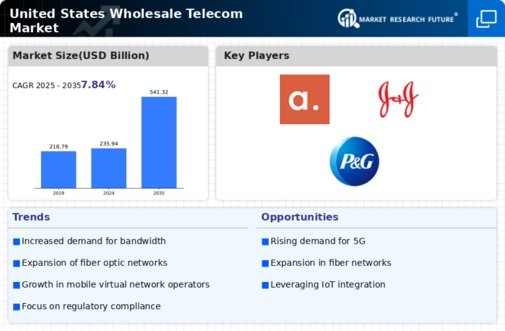Increased Demand for Bandwidth
The wholesale telecom market experiences heightened demand for bandwidth as businesses and consumers increasingly rely on high-speed internet services. This demand is driven by the proliferation of data-intensive applications, such as video streaming, cloud computing, and IoT devices. According to recent data, the bandwidth consumption in the US has surged by approximately 30% over the past year. As a result, wholesale telecom providers are compelled to enhance their infrastructure to accommodate this growth. The need for robust connectivity solutions is likely to propel investments in fiber optic networks and other advanced technologies. Consequently, the wholesale telecom market is positioned to benefit from this trend, as providers seek to meet the evolving needs of their customers.
Emergence of New Market Players
The wholesale telecom market is witnessing the emergence of new players, including regional carriers and alternative service providers. These entities often offer competitive pricing and innovative services, challenging established operators. The entry of these new competitors fosters a dynamic environment, compelling existing players to enhance their service offerings and pricing strategies. This trend is particularly evident in underserved regions, where new entrants aim to provide better connectivity options. As a result, the wholesale telecom market is likely to experience increased competition, which may lead to improved service quality and lower prices for consumers. The presence of diverse market participants could also stimulate technological advancements as companies strive to differentiate themselves.
Growing Importance of Cloud Services
The wholesale telecom market is increasingly influenced by the growing importance of cloud services. As businesses migrate their operations to the cloud, the demand for reliable and high-capacity connectivity solutions intensifies. This shift is evident in the rising number of data centers and cloud service providers establishing operations in the US. According to industry reports, the cloud services market is projected to grow by over 20% annually, further driving the need for robust telecom infrastructure. Consequently, wholesale telecom providers are likely to invest in enhancing their network capabilities to support this trend. The wholesale telecom market stands to gain from the increasing reliance on cloud-based solutions, as providers seek to offer seamless connectivity to their clients.
Shift Towards Virtualization and Automation
The wholesale telecom market is undergoing a shift towards virtualization and automation, driven by the need for greater efficiency and cost-effectiveness. Telecom operators are increasingly adopting software-defined networking (SDN) and network functions virtualization (NFV) to streamline operations and reduce reliance on physical hardware. This transition allows for more agile service delivery and improved scalability. As a result, wholesale telecom providers are likely to enhance their operational capabilities, enabling them to respond more effectively to market demands. The wholesale telecom market may experience transformative changes as companies embrace these technologies, potentially leading to lower operational costs and improved service offerings.
Regulatory Support for Infrastructure Development
The wholesale telecom market benefits from regulatory support aimed at enhancing infrastructure development. Recent initiatives by government agencies encourage investment in broadband expansion, particularly in rural and underserved areas. This regulatory environment fosters collaboration between public and private sectors, facilitating the deployment of advanced telecommunications infrastructure. As a result, wholesale telecom providers are likely to receive incentives for expanding their networks, which could lead to improved service availability and quality. The wholesale telecom market is poised to capitalize on these developments, as increased infrastructure investment may enhance competition and drive innovation within the sector.

















Leave a Comment